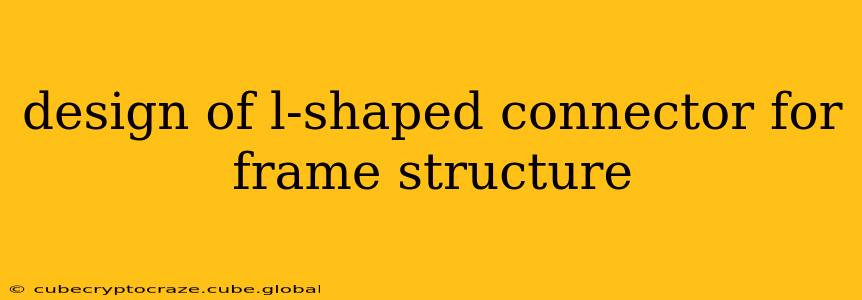L-shaped connectors are crucial components in frame structures, providing robust and efficient joining solutions for various materials. Their design requires careful consideration of several factors to ensure structural integrity, stability, and longevity. This comprehensive guide delves into the key aspects of designing effective L-shaped connectors for optimal performance in frame structures.
What are the Different Types of L-Shaped Connectors?
L-shaped connectors come in a variety of forms, each suited to specific applications and materials. Common types include:
- Welded L-shaped connectors: These are fabricated by welding two pieces of metal at a 90-degree angle. They are strong and durable, ideal for heavy-duty applications.
- Bolted L-shaped connectors: These connectors use bolts to join two members, offering easier assembly and disassembly compared to welded options. The choice of bolt size and type is crucial for ensuring sufficient strength.
- Mechanical L-shaped connectors: These connectors utilize various mechanical fastening systems, such as clamps, to join the members. They often offer a quicker and easier installation process.
- Cast L-shaped connectors: These are manufactured through casting processes, often from metal alloys. They can provide a high degree of strength and intricate designs.
The choice of connector type depends heavily on the material of the frame members (wood, steel, aluminum, etc.), the loads the connector needs to withstand, and the overall construction methods.
What Factors Influence the Design of an L-Shaped Connector?
Several critical factors influence the design of L-shaped connectors, including:
- Material Properties: The material's strength, stiffness, and ductility significantly impact the connector's design. Steel connectors, for instance, can handle higher loads than those made from aluminum.
- Load Conditions: The type and magnitude of loads (tension, compression, shear, bending) determine the connector's dimensions, thickness, and the type of fastening used. Finite Element Analysis (FEA) is frequently employed to simulate load scenarios and optimize the design.
- Connection Type: The manner in which the connector joins the frame members (butt joint, lap joint, etc.) influences the stress distribution and therefore the design requirements.
- Manufacturing Constraints: The manufacturing process, cost, and availability of materials also play a role in the final design.
- Corrosion Resistance: For outdoor applications, the connector material's corrosion resistance is vital. Galvanized steel or other corrosion-resistant materials are often preferred.
How is the Strength of an L-Shaped Connector Determined?
The strength of an L-shaped connector is assessed through various methods, including:
- Analytical Calculations: These involve applying engineering principles and formulas to determine the connector's capacity under specific load conditions.
- Finite Element Analysis (FEA): FEA uses computer software to simulate the stress and strain distribution within the connector under various load scenarios. This allows for a more precise prediction of the connector's behavior.
- Experimental Testing: Physical testing involves applying loads to the connector until failure to verify the analytical calculations or FEA results. This ensures the design meets the required safety factors.
What are Common Design Considerations for L-Shaped Connectors?
Several key design considerations ensure optimal performance:
- Appropriate Size and Thickness: The dimensions of the connector must be sufficient to withstand the anticipated loads without significant deformation or failure.
- Optimum Weld/Bolt Size and Placement: For welded connectors, the weld size and penetration must be adequate. For bolted connectors, bolt diameter, spacing, and edge distance are crucial factors.
- Stress Concentrations: Designers must minimize stress concentrations, areas of high stress, to avoid premature failure. Filleting or other design modifications can mitigate stress concentrations.
- Fatigue Resistance: For connectors subjected to cyclic loading, fatigue resistance is critical. Design considerations include using high-strength materials and avoiding sharp corners.
How do I Choose the Right L-Shaped Connector for My Project?
Selecting the appropriate L-shaped connector for a specific project requires a thorough understanding of:
- Load requirements: Determine the anticipated loads on the connector (magnitude and direction).
- Material compatibility: Ensure the connector material is compatible with the frame members.
- Installation method: Consider the ease and cost of installation.
- Environmental factors: Account for environmental conditions that might affect the connector's performance (temperature, humidity, corrosion).
- Aesthetic considerations: In some cases, the connector's appearance might be a factor.
By carefully considering these aspects, you can design and select the most suitable L-shaped connector to ensure the structural integrity and longevity of your frame structure. Remember, consulting with a structural engineer is always recommended for complex projects or applications involving significant loads.
